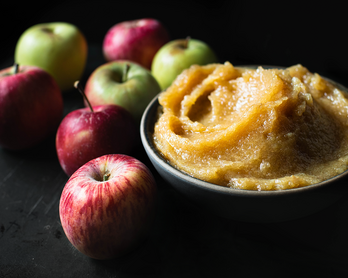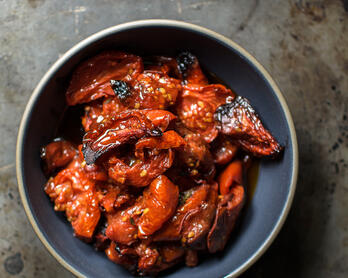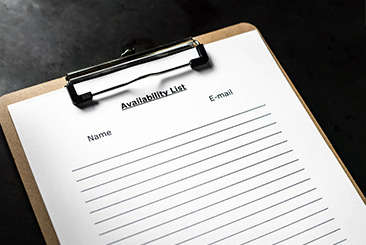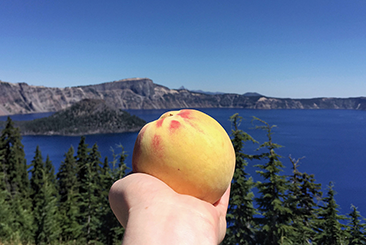Irish Soda Bread Revisited + How to Make a Cake Flour Substitute
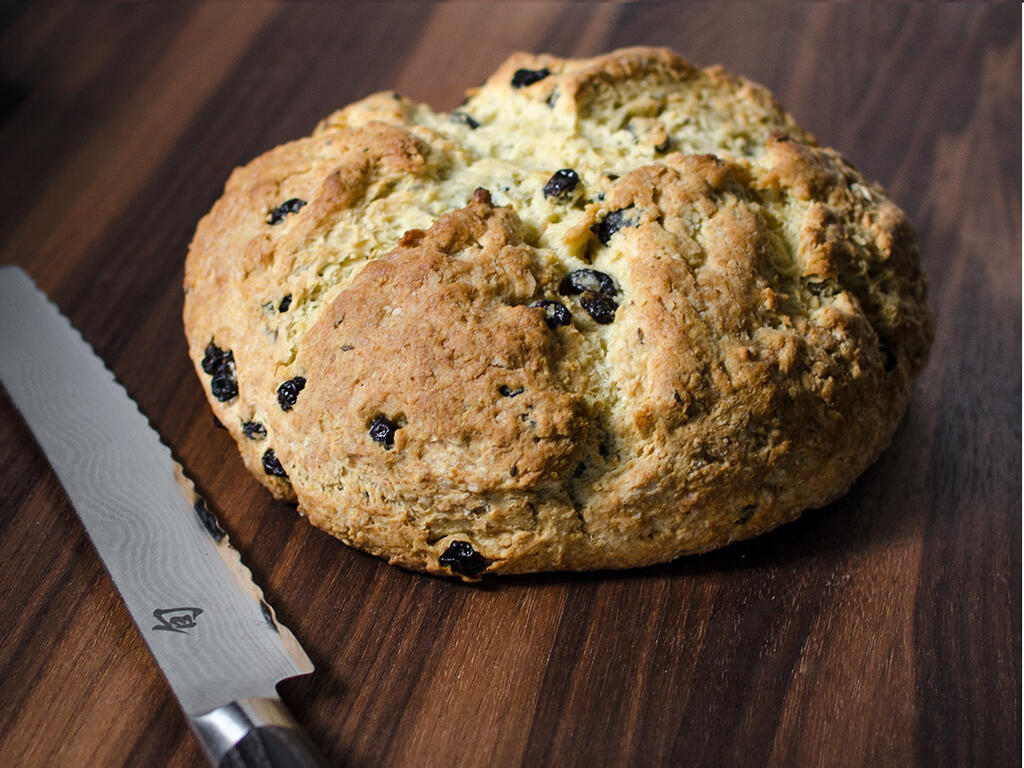
While we were lazing around on Sunday, my half-Irish husband talked me into making Irish Soda Bread a couple of days early. Unfortunately, I didn't have cake flour and wasn't interested in going to the store since the LA Marathon finish line was in our neighborhood. I asked The Google for a solution and discovered that you can replicate cake flour with a mixture of corn starch and all-purpose flour. As luck would have it...I didn't have corn starch either. What's up with these pantry deficiencies?? I finally managed to locate some potato starch that I had recently used in a stir fry. Several people on the Internets actually suggest that potato starch has a cleaner flavor than its corn cousin. Good to know.
I incorporated the cake flour substitute into an old recipe adapted from Cook's Illustrated and also changed my kneading method to ensure that the dough wasn't overworked (notes below). Since starting my sourdough journey, I'm more in tune with gluten development and how it can help or hurt a recipe. With Irish Soda Bread and flaky pastry, you want to work the dough as little as possible so the gluten doesn't develop and toughen up the final product. On the other hand, sourdough bread benefits from stretching, folding, slapping and the like. Food science at its best - be one with the gluten.
Cake Flour Substitute
Ingredients
- 1 cup all-purpose flour
- 2 tbsp corn starch or potato starch
Instructions
- Measure the all-purpose flour.
- Remove 2 tablespoons of the all-purpose flour, then add 2 tablespoons of your corn or potato starch to the remaining flour.
- Sift 4-5 times to aerate and combine.
Classic Irish Soda Bread Ingredients (Adapted from Cook's Illustrated)
Ingredients
- 3 cups (15 ounces) low-protein unbleached all-purpose flour Note: "Low protein" means avoid King Arthur which has 4g of protein per 1/4 cup. Use Gold Medal (or similar) which has 3g of protein per 1/4 cup.
- 1 cup (4 ounces) plain cake flour or cake flour substitute Note: You will have some leftover cake flour if you make the above substitute recipe.
- 2 tbsp sugar
- 1 1/2 tsp baking soda
- 1 1/2 tsp cream of tartar
- 1 3/4 tsp flake-style salt (or 1 1/2 tsp table salt)
- 2 tbsp unsalted butter, softened at room temperature
- 1 tbsp unsalted butter for the crust
- 1 tbsp unsalted butter to grease the parchment
- 1 1/2 cups buttermilk
Instructions
- Move oven rack to upper-middle position and heat to 400 degrees.
- Line a baking sheet with parchment paper and then lightly coat with butter.
- Whisk all of the dry ingredients together - flours, sugar, baking soda, cream of tartar, and salt.
- With your fingers, work the softened butter into the flour mixture until you have a coarse texture. Note: You can also use two forks to cut the butter into the flour.
- Add the buttermilk and stir until the dough starts to come together.
- Transfer the dough to a lightly floured surface, then knead a handful of times until it's cohesive, the dry bits are gone, but it's still lumpy. My kneading method is as follows:
- Once the roughly assembled dough is transferred from the bowl to the counter, use a pastry scraper to scoop and fold the outer edges towards the middle. Work your way around the dough in a north/south/east/west fashion. Rather than kneading in the traditional sense, simply press the scooped edges into the center of the mound. If you work your way around the dough 2-3 times (so 8-12 "presses"), the dough will come together into a cohesive ball.
- It's really important that you don't knead the dough beyond forming it into a cohesive loaf. Ugly is desirable.
- Form the dough into a 6-inch round loaf, score the top, and then bake for 40-45 minutes. Note: The internal temperature should be around 175. Using a thermometer is the best way to tell if the bread is done.
- Once the bread is finished baking, brush the top with the melted butter (on the parchment since that makes for easy cleanup), and then cool on a wire rack.
American-style Irish Soda Bread Ingredients (Adapted from Cook's Illustrated)
Ingredients
- 3 cups (15 ounces) low-protein unbleached all-purpose flour Note: "Low protein" means avoid King Arthur which has 4g of protein per 1/4 cup. Use Gold Medal (or similar) which has 3g of protein per 1/4 cup.
- 1 cup (4 ounces) plain cake flour or cake flour substitute Note: You will have some leftover cake flour if you make the above substitute recipe.
- 3 1/2 tbsp sugar
- 1 1/2 tsp baking soda
- 1 1/2 tsp cream of tartar
- 1 3/4 tsp flake-style salt (or 1 1/2 tsp table salt)
- 4 tbsp unsalted butter, softened at room temperature
- 1 tbsp unsalted butter for the crust
- 1 tbsp unsalted butter to grease the parchment
- 1 1/4 cups buttermilk
- 1 egg, lightly beaten
- 1 cup raisins
- 1 tablespoon caraway seeds
Instructions
- Move oven rack to upper-middle position and heat to 400 degrees.
- Line a baking sheet with parchment paper and then lightly coat with butter.
- Whisk all of the dry ingredients together - flours, sugar, baking soda, cream of tartar, and salt.
- With your fingers, work the softened butter into the flour mixture until you have a coarse texture. Note: You can also use two forks to cut the butter into the flour.
- Combine the egg, buttermilk, raisins, and caraway seeds, and then add mixture to the flour and stir until the dough just starts to come together.
- Transfer the dough to a lightly floured surface, then knead a handful of times until it's cohesive, the dry bits are gone, but it's still lumpy. My kneading method is as follows:
- Once the roughly assembled dough is transferred from the bowl to the counter, use a pastry scraper to scoop and fold the outer edges towards the middle. Work your way around the dough in a north/south/east/west fashion. Rather than kneading in the traditional sense, simply press the scooped edges into the center of the mound. If you work your way around the dough 2-3 times (so 8-12 "presses"), the dough will come together into a cohesive ball.
- It's really important that you don't knead the dough beyond forming it into a cohesive loaf. Ugly is desirable.
- Form the dough into a 6-inch round loaf, score the top, and then bake for 40-45 minutes. Note: The internal temperature should be around 175. Using a thermometer is the best way to tell if the bread is done.
- Once the bread is finished baking, brush the top with the melted butter (on the parchment since that makes for easy cleanup), and then cool on a wire rack.
Serving Suggestion
- Whipped butter
- Jam (on it) - I love eating a warm piece of Classic Irish Soda Bread with strawberry jam and a little butter.
- Sauce Mop - Serve alongside your favorite Irish stew.
Storage
- Irish Soda Bread does not keep for very long, maybe a day or two. The texture is best the day it's made.
- To store, I wrap the loaf in a dish towel and set it on the kitchen counter.


